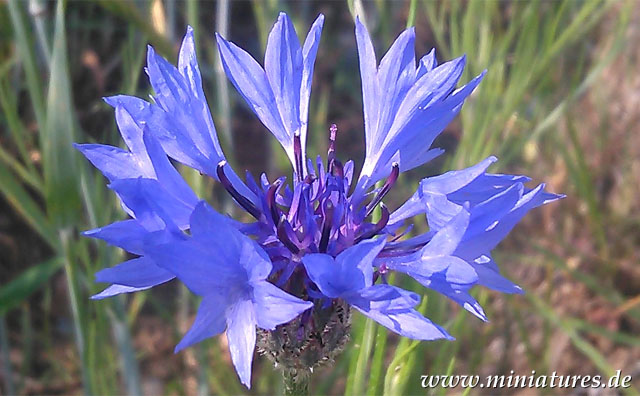Cornflower blue

Cornflower blue (French bleu bleuet or bleu barbeau), the light blue (cyan) colour of the cornflower (Cyanus segetum).
In English sources, the uniform coat colour of Bavarian infantry is often described as “cornflower blue”. Friedrich Münich, captain in the Royal Bavarian 1. Infanterie-Regiment König Ludwig, writes of the uniform of the army of the Electorate of Bavaria under Ferdinand Maria von Bayern (1651–1679) “The infantry uniform was blue, their flags had white and blue rhombi”[1]. The decree of March 14, 1684 specified the colour of the infantry uniform as consistently blue, with coloured facings[2]. During the reign of Carl Albrecht (1726–1745), nothing significant changed in infantry uniforms; “during the War of War of Succession, the officers wore field signs of blue and white ribbon on their hats”[3]. Knötel-Sieg describe the colour of the Bavarian infantry uniform of the Seven Years’ War as “light blue”[4].
Bavarian blue appears to have been lighter than the Parisian or Prussian blue. It remains unclear whether the Bavarian uniforms were dyed in a lighter blue to begin with, or simply faded more because they had to be worn longer for economic reasons. The Prussian soldier normally received a new coat every year, his Bavarian colleague had to wear his uniform for three years until there was a replacement. The interesting question is whether and to what extent the uniforms of new recruits and better-dressed Bavarian officers differed from the faded, tattered and patched coats of the other ranks.
In 1774 all Bavarian regiments had to have their uniform coats lined in white; the basic coat colour was dark blue[5].
Sources
- [1] Münich, Friedrich (MGBA): Geschichte der Entwicklung der bayerischen Armee seit zwei Jahrhunderten (1618–1818), p. 32
- [2] Archiv-Conservatorium München, Akt. Nr. 161
- [3] Münich, Friedrich (MGBA): Geschichte der Entwicklung der bayerischen Armee seit zwei Jahrhunderten (1618–1818), p. 72
- [4] Knötel-Sieg: Handbuch der Uniformkunde, p. 52
- [5] Münich, Friedrich (MGBA): Geschichte der Entwicklung der bayerischen Armee seit zwei Jahrhunderten (1618–1818), p. 89